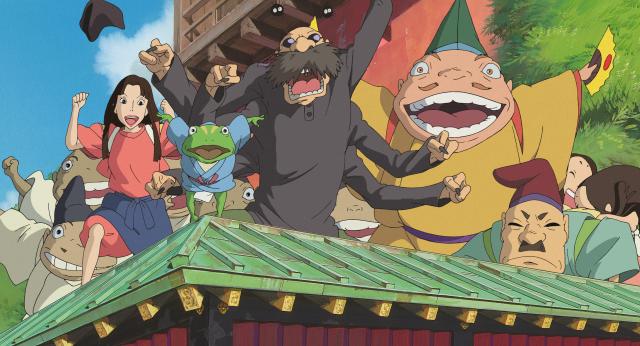
Anime studio shares new production secrets, including the real inspiration behind the bathhouse.
On 7 January, Japanese broadcaster Nippon TV aired Studio Ghibli’s 2001 blockbuster hit Spirited Away in its first “Friday Roadshow” weekly movie slot for 2022.
To celebrate the TV event, Nippon TV announced that Ghibli staff would be on hand during the broadcast to answer select questions submitted by fans in advance via Twitter. Nippon TV made the announcement via their official Twitter account on 27 December, allowing plenty of time for fans to submit questions, using the hashtag #千と千尋の質問 (“Sen to Chihiro no Shitsumon”), which means “Spirited Away Questions”.
▼ Spirited Away‘s Japanese title is “Sen to Chihiro no Kamikakushi“, which translates to “Sen and Chihiro’s Spiriting Away“.
今回も😉
— アンク@金曜ロードショー公式 (@kinro_ntv) December 26, 2021
✨#スタジオジブリ 公式❌#金曜ロードショー 公式 コラボ企画✨
「千と千尋の神隠し」に関する質問 受付中👍
この投稿に返信し「#千と千尋の質問」を付けて質問を書き込んでください❗️
年明け1月7日の「千と千尋の神隠し」放送中、ジブリ公式アカウントから皆さんの質問にお答えします😊 pic.twitter.com/ykWQhuLRoX
When the show began at 9:00 p.m. on Friday, viewers in Japan sat down to watch the beloved film with one eye on Twitter for updates from the official Studio Ghibli account. The studio didn’t disappoint, revealing dozens of different anecdotes and behind-the-scenes information about the film, many of which had never been discussed before now.
So let’s take a look at some of the revelations, shall we?
Starting with…
The fact that the movie’s director, Hayao Miyazaki, was unfazed by the broadcast when it started. According to this tweet from Studio Ghibli, this is the conversation staff had with the director when the broadcast was due to begin:
Staff: “Mr Miyazaki, Spirited Away is starting now on TV.”
Miyazaki: “Eh? Why is it on now? Never mind. Ah, what a great moon.”
Miyazaki may have been more enamoured by the moon outside than the broadcast on TV, but, as always, Ghibli producer, co-founder and close pal of Miyazaki’s, Toshio Suzuki, was much more enthusiastic about the event, sharing this video message with fans.
▼ “Happy New Year. This evening is…the New Year’s broadcast of Spirited Away on Nippon TV. Please give it a watch.”
https://twitter.com/JP_GHIBLI/status/1479415016575152130As the show got underway, so did the revelations, which included the following highlights.
The Original Title of the Film
Q: Why did you decide on the title “Sen to Chihiro no Kamikakushi”? Were there any other title candidates?
A: At the stage of the proposal that was drafted on 2 November, 1999, it was “Sen no Kamikakushi”. At some stage, because the film was Chihiro’s story, the title became “Sen to Chihiro no Kamikakushi”.
The Rock in Front of the Tunnel
Q: What’s the meaning behind the mysterious Dharma-like rock in front of the tunnel?
A: “Seki jin (actually frog person)” is written on the image board.
▼ In Japan, ‘Sekijin’ is a stone image of a person, and this one does look a bit like a frog.
https://twitter.com/JP_GHIBLI/status/1479423854309429256The tunnel from Spirited Away is being made at Ghibli Park!
Q: Are there plans to build that tunnel in Ghibli Park?
A: We asked Goro, who is building the acclaimed Ghibli Park. Goro said: “I’m making ‘that’ tunnel from ‘that’ work (laughs)”
Goro is Miyazaki’s son, who, aside from directing anime films like Tales from Earthsea, From Up on Poppy Hill, and Earwig and the Witch, also played a main role in the construction of the Ghibli Museum in Tokyo’s Mitaka, and served as its first director. News that the tunnel from Spirited Away will be built at Ghibli Park is an extremely exciting revelation, seeing as a lot of the details are being kept hush-hush until the park’s opening this autumn.
The Inspiration for the Mysterious Town at the Beginning of the Film
Q: I’d like to know more about the things and locations etc that were used as references in the making of this work.
A: Locations weren’t specified as “this place”. Miyazaki recalls places he’s visited and draws them while using his imagination to fill in the parts he can’t recall. The mysterious restaurant district that appears at the beginning of the film is said to have been drawn with the image of bar districts from Yurakucho and Shinbashi in mind.
Yurakucho and Shinbashi’s dining districts are filled with tightly packed bars, casual outdoor crate or stool seating and hanging lanterns, which create a fantastic atmosphere at night. The dining establishments in the film are slightly more magical than those in real-life, though.
Rin May Not Be Human
Q: Are characters like Rin, who are drawn as human, human? Or are they some other type of creature?
A: With the workers at the bathhouse, the men are frogmen and the women are slugs. It seems to be symbolic of how all the older guys at Ghibli look the same to new hires at Ghibli. Rin is a close senior [to Chihiro] so she may look like a human being.”
https://twitter.com/JP_GHIBLI/status/1479432193726631942The Gods in the Baths
Q: I want to know more about the chicks who are crammed in the bath!
A: They are chick gods/spirits called “Ootori-Sama”. By the way, “Ushi Oni” also soak in these waters. According to Miyazaki, he thought “It’s tough for the Japanese gods of today” and so the bathhouse where gods and yokai could heal their fatigue was born. Now, 20 years later, that bathhouse might be flourishing even more…..
▼ Ootori-Sama, one of the supporting characters to be included in this Studio Ghibli figurine collection.
https://twitter.com/JP_GHIBLI/status/1479432586183454726▼ Ushi Oni (literally “Cow Demon”)
油屋の客の中にいたこれらの神様は「牛鬼」といいます。頭が牛、首から下が鬼で、日本の古典文学にもこの名前が登場しています。湯舟に浸かっているタイプの牛鬼(画像1)が被るお面は、雅楽「蘇利古」である雑面がモチーフと思われます。#千と千尋の神隠し pic.twitter.com/u7pu7Jp8mU
— キャッスル@ジブリフリーク (@castle_gtm) August 16, 2019
▼ Speaking of Ushi Oni, is it just us or does this 1737 rendering of an Ushi Oni look a liiitle bit like No Face?
▼ No Face even had similar pointy appendages when we shook hands with it in 2019.
The Bathhouse is Modelled on…Studio Ghibli?!
Q: Regarding the bathhouse world, approximately what year was it set in?
A: It’s modelled on ‘Giyofu’ buildings that were popular from the end of the Edo period to the beginning of the Meiji era, so it can be interpreted as after that. The actual model, though, is Studio Ghibli. To work at Studio Ghibli, you have to go up to Suzuki on the top floor and say, “Please let me work” (laughs).
Giyofu was a style of Japanese architecture that mimicked Western-style facades but actually used traditional Japanese building techniques. While it was popular during the early Meiji period (1868-1912), it disappeared once knowledge of Western building techniques became more widespread.
As for the comment about having to ask Suzuki for a job on the top floor of Studio Ghibli, that’s another correlation between new hires at Studio Ghibli and Chihiro’s experience. In the film, Chihiro takes the elevator up to the top floor to ask Yubaba for a job, which makes us wonder…is Yubaba modelled on Toshio Suzuki?
https://twitter.com/JP_GHIBLI/status/1479435475090042883The contents of Haku’s Rice Ball
Q: I have a feeling the rice ball Haku gave to Chihiro was a plain white rice ball, but was there something inside it?
A: The storyboard says: “Three rice balls (without seaweed)”. I’ll leave it up to your imagination whether it contained any ingredients (that doesn’t mean there’s wasabi in it).
▼ That last comment about wasabi in the rice ball is likely in reference to tongue-in-cheek fan theories that it’s the reason why tears well from Chihiro’s eyes while she eats it.
The Creation of No Face
Q: No Face’s movements are a bit cat-like…? That’s what I personally think, but were there any animals etc that you referred to [for the character]?
A: “Animals” as such weren’t used as a reference, but staff at the time said, “We felt like we were consolidating the sick parts of people with obsessions that everyone has.”
The Truth About No Face
Q: Is No Face a god? Is there a reason why he wasn’t allowed in the bathhouse?
A: No Face isn’t a god, but Miyazaki remarked at the time, “No Face is inside all of us”.
https://twitter.com/JP_GHIBLI/status/1479439849115774977That’s certainly a deep statement, but it’s one that rings true. No Face is like the self-serving, indulgent side that lives inside all of us. Whether we allow that side to grow wild or choose to tame it instead is entirely up to us.
A Scene Based on a Real-Life Event
Some of the questions and answers during the evening were interspersed with anecdotes, and when the scene showing the Stink Spirit polluting the bathhouse appeared on TV, the Ghibli account lit up with this tweet:
“The scene where a bicycle appears out of the Stink Spirit really happened when Miyazaki was cleaning a river.”
Miyazaki regularly takes part in volunteer cleanups around his home and the Totoro Forest, so he’s witnessed the effects of pollution firsthand. He’s also borne witness to the effects of a good cleanup, though, which no doubt influenced the scene in which the Stink Spirit was eventually purified, revealing its true identity as a — spoiler alert! — peaceful river god.
The Meaning Behind the Name No Face
Q: Why is No Face called ‘No Face’?
A: At the drawing meeting at that time, Miyazaki said that Yubaba, No Face, and Chihiro each represent “one face of an individual.” Everyone has good and bad points. I believe he created a character called No Face to symbolise the fact that human beings can’t be drawn with just one side to them.
Spirited Away Wasn’t Made for an Overseas Audience
Q: When it was released overseas, what kind of reaction and impressions did Japanese concepts such as Japanese gods and spiriting away have [on foreign audiences]? Also, at the time of production, was it made with overseas reactions in mind?
A: Reactions varied from country to country. There were countries where No Face’s appearance stole the show and others where it was met with laughter. Miyazaki doesn’t make movies with overseas reactions in mind. Suzuki says, “If Japanese people make things that only Japanese people can make, it will become a global work.”
Natsuki Mari’s Powerful Voice
This interesting anecdote reveals some background info on Mari Natsuki’s voice acting, when she recorded the roles of Yubaba and Zeniba. According to the studio:
“When Mari Natsuki shouted “Sen!” the lighting fixtures in the preview room vibrated and made noises, so there were times we had to do retakes. As always, such a powerful voice!”
▼ Natsuki gives us all a quick sample of her vocal talents
https://twitter.com/JP_GHIBLI/status/1412909290944299010The Difference Between Yubaba and Zeniba
Q: Please tell me how to make the distinction between Yubaba and Zeniba.
A: At the image board stage [which uses images to give staff an initial understanding of characters] there were distinct differences between Zeniba and Yubaba. At the storyboard stage, it was thought that it would be better to have them look exactly alike. One staff member said, “Yubaba has one wart on her chest and Zeniba has four warts on her chest” but we can’t confirm that (laughs).
▼ What the sisters initially looked like
https://twitter.com/JP_GHIBLI/status/1479449324807663616The Reason Behind the Dragon Ball-Esque Move
Q: Why did you make the “Not in my house!” scene like Dragon Ball? Why did Yubaba shoot that ball of light?
[The “Not in my house!” scene is the one where Yubaba stands in the path of a rampaging No Face and generates a ball of light between her palms, which she then throws at No Face.]
A: “Like Dragon Ball” is written on the storyboard (laughs). It’s not certain why she shot that ball of light, but Miyazaki has said, “Yubaba is a grandma who can swim through mid-air”.
▼ Yubaba is so powerful she can perform all kinds of magic, even energy attacks like the Kamehameha.
https://twitter.com/JP_GHIBLI/status/1479452652874641413No Face’s Voice Acting
Now for another anecdote, this time regarding No Face’s “after recording”, when Akio Nakamura, the character’s voice actor, was required to add sounds in the post-recording.
“No Face’s after recording was a series of non-stop raucous laughter.
‘Please do a sadder ‘ah”
‘Ah’
‘A sadder ‘ah'”
‘Ah……’
As we know from our own reporter voicing characters in Hollywood’s latest Superman films, sometimes it’s the shortest words that take the longest time to perfect.
The Part That Took the Longest to Draw
Q: Which scenes took the longest time to draw?
A: If there are many characters, it will take time [to draw], but there’s no way to clearly say “this cut” took the longest. I don’t know if it took the longest time, but Miyazaki often redrew the details for Chihiro’s gestures, and in particular, he seems to have worked hard to fix the scene where Chihiro receives a hair tie from Zeniba and uses it to tie her hair.
The Secret Behind the Pigs
Q: How did Chihiro realise her parents weren’t in the group of pigs at the end?
A: I’m not sure of the reason, but please have a read of the children’s novel Krabat, which Miyazaki-san was greatly influenced by.
Krabat is a 1971 fantasy novel written by Otfried Preußler, which deals with the lure of evil and black magic. There’s a scene in the book where the main character distinguishes the transformed crow from 12 crows, which is likely the inspiration behind the scene in Spirited Away.
The One Thing Chihiro Takes Home From the World of Spirited Away
Q: Is there a reason why Chihiro’s hair tie glistens at the end?
A: That hair accessory is the only proof that Chihiro worked at the bathhouse. It can be said that it was a direction choice to leave an impression [on the viewer].
▼ The scene where Chihiro eventually looks back at the end with the hair tie in her hair is so profound it has a spot on the wall at Studio Ghibli.
https://twitter.com/JP_GHIBLI/status/1479459819736412161How Long Was Chihiro Spirited Away For?
Q: About how many days was the entire affair — Chihiro getting lost in the mysterious town, working in the bathhouse, and leaving the tunnel?
A: Suzuki advocates the three-day theory. When Chihiro’s parents get into the car as if nothing had happened, the inside of the car is full of dust, so the passage of time may change from one end of the tunnel to another.
Was There Ever a Reunion?
Q: Did Chihiro and Haku ever meet afterwards?
A: Haku was the spirit of the river that runs near the house where Chihiro used to live. If Chihiro ever visits that river…
▼ This final Q & A tweet, referring to a possible river reunion, was one of the most liked of the night, receiving over 100,000 likes.
https://twitter.com/JP_GHIBLI/status/1479460663865262080The very last tweet of the day, however, was a plug for Masashi Ando, who worked as the animation director and character designer for Ghibli’s Princess Mononoke and Spirited Away.
▼ “The Deer King: The Promised Journey With Yuna” directed by Masashi Ando, who kindly drew Chihiro and Haku for us for the first time in 20 years, will be released on Friday, 4 February.”
https://twitter.com/JP_GHIBLI/status/1479461068040818694And with that final tweet of the day, the TV Twitter event came full circle, with the studio ending on the very same image of Chihiro and Haku that they started the day with.
▼ Starting and ending the special broadcast day with the same image.
https://twitter.com/JP_GHIBLI/status/1479226272530112513Ando left Ghibli following a directorial spat with Miyazaki after Spirited Away — and eventually went on to work as the animation director for Your Name, the film that threatened to topple Spirited Away at the box office — so it’s nice to see that Ando remains on good terms with the studio.
There should be no reason for any animosity really, as Suzuki says he sees a lot of Miyazaki’s influence in Ando’s style, and as for Miyazaki, he couldn’t care less about competitors. He’s just a retired old man picking up trash.
Source: Twitter/@JP_GHIBLI
Featured image: Studio Ghibli
Insert images: Studio Ghibli (1, 2, 3, 4, 5,), Wikipedia/Sawaki Suushi, SoraNews24
● Want to hear about SoraNews24’s latest articles as soon as they’re published? Follow us on Facebook and Twitter!


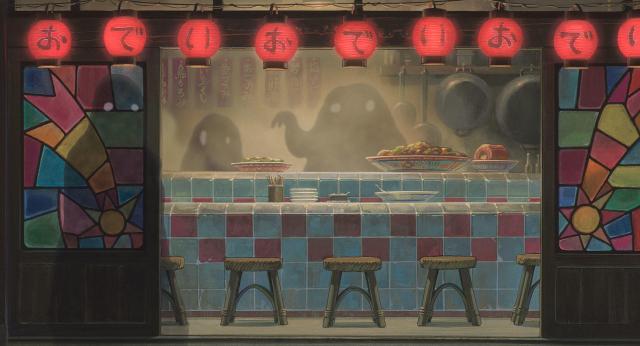
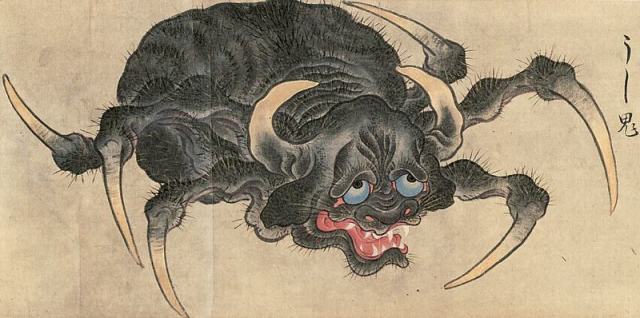
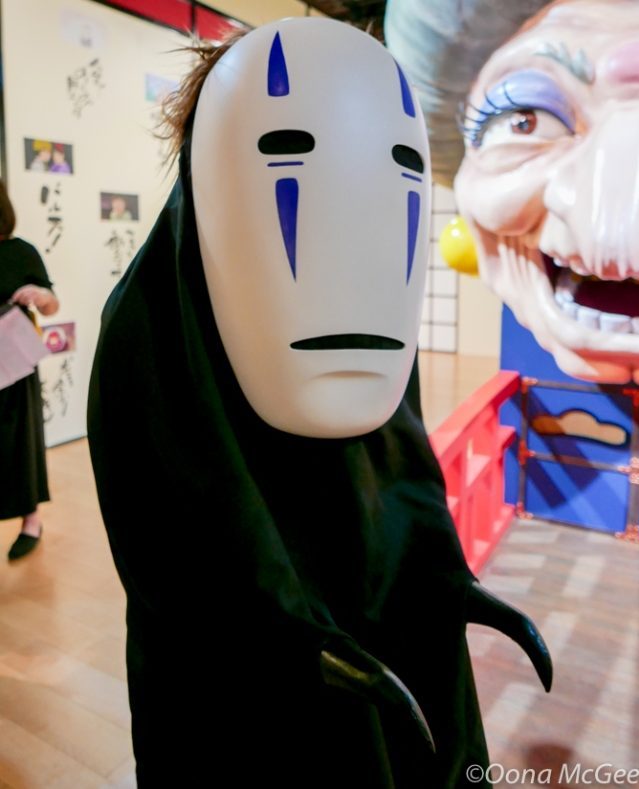
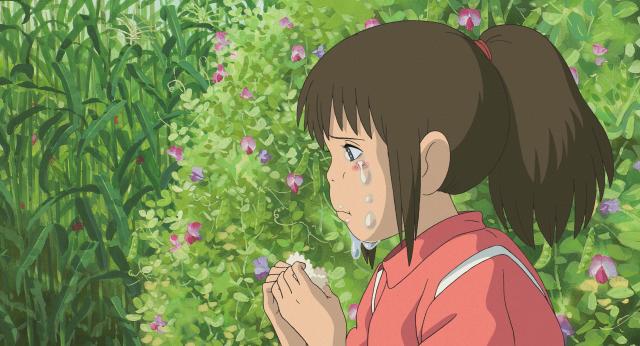
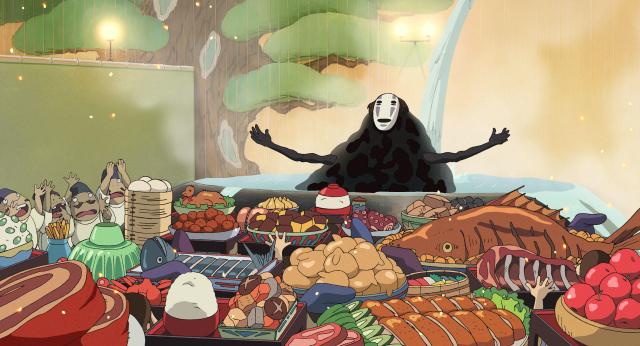
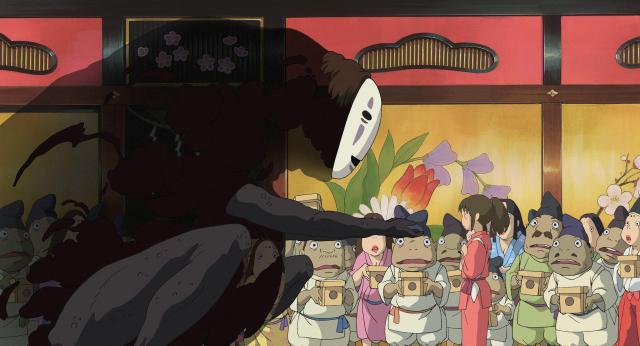
 New Studio Ghibli exhibition opens in Tokyo, features giant talking Yubaba from Spirited Away
New Studio Ghibli exhibition opens in Tokyo, features giant talking Yubaba from Spirited Away First look at Studio Ghibli’s new Spirited Away live-action stage play
First look at Studio Ghibli’s new Spirited Away live-action stage play Spirited Away meals and merchandise coming to new Studio Ghibli exhibition in Tokyo
Spirited Away meals and merchandise coming to new Studio Ghibli exhibition in Tokyo Soak your feet at the Spirited Away foot bath, in Tokyo for a limited time
Soak your feet at the Spirited Away foot bath, in Tokyo for a limited time Yubaba and Zeniba pen stands from Studio Ghibli capture the magic of Spirited Away
Yubaba and Zeniba pen stands from Studio Ghibli capture the magic of Spirited Away Majority of Japanese mayors say foreign residents are essential but most see good and bad effects
Majority of Japanese mayors say foreign residents are essential but most see good and bad effects Should you dip your cake in sake? One Japanese brewer says no, but actually yes【 Taste test】
Should you dip your cake in sake? One Japanese brewer says no, but actually yes【 Taste test】 Japanese beef bowl chain Sukiya’s 2026 Smile Box lucky bag basically pays for itself
Japanese beef bowl chain Sukiya’s 2026 Smile Box lucky bag basically pays for itself Village Vanguard’s most expensive Black Lucky Bag sets an ominous tone for 2026
Village Vanguard’s most expensive Black Lucky Bag sets an ominous tone for 2026 What did Shibuya really look like after the crowds on New Year’s Day?
What did Shibuya really look like after the crowds on New Year’s Day? Pizza Hut Japan’s hot lucky bags are perfect for a New Year’s pizza party
Pizza Hut Japan’s hot lucky bags are perfect for a New Year’s pizza party That time Seiji called JASRAC to ask why he didn’t get paid royalties for his song being on TV
That time Seiji called JASRAC to ask why he didn’t get paid royalties for his song being on TV We revisited Sweets Paradise after a decade to see if Japan’s dessert buffet still delivers
We revisited Sweets Paradise after a decade to see if Japan’s dessert buffet still delivers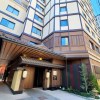 Japanese-style accommodation at the new Premium Dormy Inn hotel in Asakusa will blow your mind
Japanese-style accommodation at the new Premium Dormy Inn hotel in Asakusa will blow your mind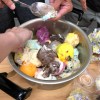 We mixed all 31 flavors of Baskin Robbins ice cream and created a Frankenstein dessert【Video】
We mixed all 31 flavors of Baskin Robbins ice cream and created a Frankenstein dessert【Video】 Starbucks Japan ready to get Year of the Horse started with adorable drinkware and plushies【Pics】
Starbucks Japan ready to get Year of the Horse started with adorable drinkware and plushies【Pics】 Hayao Miyazaki says Happy New Year to Studio Ghibli fans with new art for Year of the Horse
Hayao Miyazaki says Happy New Year to Studio Ghibli fans with new art for Year of the Horse 7 great places to see Mt. Fuji from without having to climb it
7 great places to see Mt. Fuji from without having to climb it We found possibly the quietest Japanese-style hotel in Tokyo’s bustling Shinjuku district
We found possibly the quietest Japanese-style hotel in Tokyo’s bustling Shinjuku district Cup Noodle tries an authentic Jiro-style ramen, but something’s not quite right
Cup Noodle tries an authentic Jiro-style ramen, but something’s not quite right Hello Kitty Choco Egg figures are an adorable trip through three periods of Japanese pop culture【Pics】
Hello Kitty Choco Egg figures are an adorable trip through three periods of Japanese pop culture【Pics】 Japan’s oldest largetooth sawfish in captivity back on display in Mie Prefecture
Japan’s oldest largetooth sawfish in captivity back on display in Mie Prefecture Cyberpunk anime meets traditional culture in Ghost in the Shell gold leaf Japanese changing screens
Cyberpunk anime meets traditional culture in Ghost in the Shell gold leaf Japanese changing screens The best Starbucks Japan Frappuccinos we want to drink again in 2026
The best Starbucks Japan Frappuccinos we want to drink again in 2026 7-Eleven Japan starts new temporary luggage storage service in over 300 branches
7-Eleven Japan starts new temporary luggage storage service in over 300 branches Disillusionment at Tsukiji’s tourist-target prices led us to a great ramen restaurant in Tokyo
Disillusionment at Tsukiji’s tourist-target prices led us to a great ramen restaurant in Tokyo Starbucks teams up with 166-year-old Kyoto doll maker for Year of the Horse decorations【Photos】
Starbucks teams up with 166-year-old Kyoto doll maker for Year of the Horse decorations【Photos】 Tokyo considering law requiring more trash cans following litter increase in heavily touristed area
Tokyo considering law requiring more trash cans following litter increase in heavily touristed area Tokyo’s Tsukiji sushi neighborhood asks tour groups to stay away for the rest of the month
Tokyo’s Tsukiji sushi neighborhood asks tour groups to stay away for the rest of the month Tokyo event lets you travel back in time, for free, to celebrate 100 years since Showa era start
Tokyo event lets you travel back in time, for free, to celebrate 100 years since Showa era start Sanrio theme park in Japan announces plans to expand into a Sanrio resort
Sanrio theme park in Japan announces plans to expand into a Sanrio resort Japan may add Japanese language proficiency, lifestyle classes to permanent foreign resident requirements
Japan may add Japanese language proficiency, lifestyle classes to permanent foreign resident requirements Stamina-destroying “Paralysis Noodles” are Tokyo’s newest over-the-top ramen innovation
Stamina-destroying “Paralysis Noodles” are Tokyo’s newest over-the-top ramen innovation Survey asks foreign tourists what bothered them in Japan, more than half gave same answer
Survey asks foreign tourists what bothered them in Japan, more than half gave same answer Japan’s human washing machines will go on sale to general public, demos to be held in Tokyo
Japan’s human washing machines will go on sale to general public, demos to be held in Tokyo Japan’s deadliest food claims more victims, but why do people keep eating it for New Year’s?
Japan’s deadliest food claims more victims, but why do people keep eating it for New Year’s? We deeply regret going into this tunnel on our walk in the mountains of Japan
We deeply regret going into this tunnel on our walk in the mountains of Japan Studio Ghibli releases Kodama forest spirits from Princess Mononoke to light up your home
Studio Ghibli releases Kodama forest spirits from Princess Mononoke to light up your home Major Japanese hotel chain says reservations via overseas booking sites may not be valid
Major Japanese hotel chain says reservations via overseas booking sites may not be valid Put sesame oil in your coffee? Japanese maker says it’s the best way to start your day【Taste test】
Put sesame oil in your coffee? Japanese maker says it’s the best way to start your day【Taste test】 No more using real katana for tourism activities, Japan’s National Police Agency says
No more using real katana for tourism activities, Japan’s National Police Agency says Starbucks Japan reveals new sakura drinkware collection, inspired by evening cherry blossoms
Starbucks Japan reveals new sakura drinkware collection, inspired by evening cherry blossoms Updated cherry blossom forecast shows extra-long sakura season for Japan this year
Updated cherry blossom forecast shows extra-long sakura season for Japan this year Japanese city getting Spirited Away buses to celebrate Studio Ghibli anime producer museum event
Japanese city getting Spirited Away buses to celebrate Studio Ghibli anime producer museum event Main cast for Spirited Away live-action stage play finally revealed!
Main cast for Spirited Away live-action stage play finally revealed! Spirited Away’s No-Face, Yubaba appear in seaside park in Japan as Ghibli museum exhibit opens 【Vid】
Spirited Away’s No-Face, Yubaba appear in seaside park in Japan as Ghibli museum exhibit opens 【Vid】 Spirited Away bathhouse spirits steal the spotlight in new Studio Ghibli finger puppet collection
Spirited Away bathhouse spirits steal the spotlight in new Studio Ghibli finger puppet collection Spirited Away live-action stage play opens in Tokyo, and the photos look amazing
Spirited Away live-action stage play opens in Tokyo, and the photos look amazing Spirited Away bath herbs now available at Ghibli exhibition in Japan
Spirited Away bath herbs now available at Ghibli exhibition in Japan Haku is…Chihiro’s dead brother? Studio Ghibli fans blown away by Spirited Away theory
Haku is…Chihiro’s dead brother? Studio Ghibli fans blown away by Spirited Away theory Studio Ghibli adds a Spirited Away jewellery box to its merchandise range in Japan
Studio Ghibli adds a Spirited Away jewellery box to its merchandise range in Japan Studio Ghibli animator reveals the secret food eaten by Chihiro’s parents in Spirited Away
Studio Ghibli animator reveals the secret food eaten by Chihiro’s parents in Spirited Away Spirited Away x Loewe pop-up store in Harajuku whisks visitors away to the world of Studio Ghibli
Spirited Away x Loewe pop-up store in Harajuku whisks visitors away to the world of Studio Ghibli Tattoos, murder, and a Totoro connection? Studio Ghibli reveals secrets of Princess Mononoke
Tattoos, murder, and a Totoro connection? Studio Ghibli reveals secrets of Princess Mononoke Studio Ghibli producer makes bombshell anime revelations during online Q&A
Studio Ghibli producer makes bombshell anime revelations during online Q&A Studio Ghibli releases wallpapers for Ghibli Park, introduces us to two new forest characters
Studio Ghibli releases wallpapers for Ghibli Park, introduces us to two new forest characters Studio Ghibli releases new Spirited Away kami collection
Studio Ghibli releases new Spirited Away kami collection Could Spirited Away’s Yubaba actually be the ideal boss that Japan’s workforce needs?
Could Spirited Away’s Yubaba actually be the ideal boss that Japan’s workforce needs?
Leave a Reply